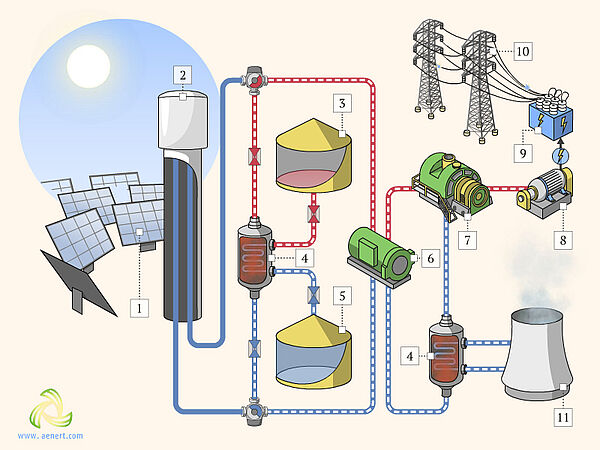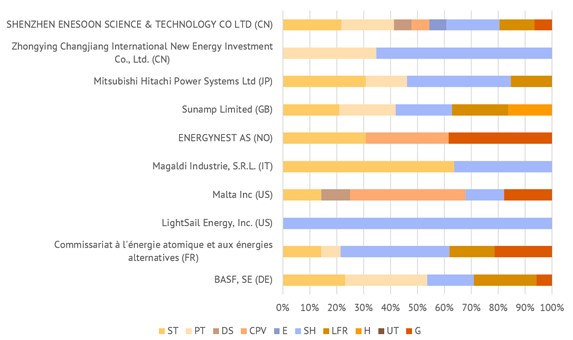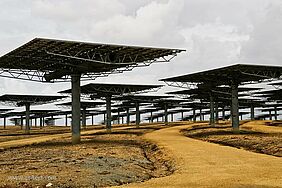Energy storage technologies constitute one of the most important domains of the modern energy industry. The key problem holding back the development of renewable energy is the variability in operation of solar and wind power plants due to the natural characteristics of these resources. The development and improvement of high-capacity energy storage technology largely determines the further development and competitiveness of these technologies. Hydraulic Pumped Storage stations are the only current option for large-scale renewable energy storage. However, these are very expensive structures that require specific landscapes and sufficient water resources.
Concentrating solar power technologies allow for the highly efficient storage of energy on account of the intermediate stage of heat production, often consumed for heating additional heat-transfer liquid stored in special thermal insulated storages (tanks) and utilized for the production of superheated steam as required when direct sunlight is not available. This gives CSP an advantage over PV technologies, partly compensating for their main disadvantage – the inability to function in the absence of direct sunlight.
Concentrated Solar Power stations combined with thermal energy storage technologies are one of the most realistic options for overcoming this barrier. An efficient energy storage system enables the extension of the operation hours of solar energy power plants, reducing the dependence between the output performance and unfavourable weather conditions, such as low solar activity or cloud cover.
Layout of a solar power plant with an energy storage facility
1. Heliostat field 2. Central receiver 3. Salt tank (hot 565oC) 4. Condenser 5. Salt tank (cold 290oC) 6. Steam generator 7. Turbine 8. Generator 9. Transformer 10. Grid 11. Cooling tower
The company Enertechup has prepared a patent database "CONCENTRATED SOLAR POWER. Energy Storage"
The database includes patent documents that were carefully collected from the publicly available sources and, according to the authors, to the greatest degree represent the latest innovations in the particular energy industry as of the date of the database preparation.
A selection of patents and patent applications related to concentrated solar power energy storage systems and published by patent offices around the globe in 1998-2021 is provided in the present database. The database also includes some related patent documents that are associated with other sectors of solar energy, but propose technical solutions that can actually be used in Concentrated Solar Power, for instance, design and composition of heat-insulation, CPV technologies, various auxiliary devices and methods, measuring systems, configurations of entire solar power station, hybrid stations, etc.
The database also includes statistical analysis for major parameters of patent documents published during the 20-year period between 2002-2021. In particular, the statistical analysis includes a breakdown of documents by publication dates, by patent families, by patent offices, by residents and non-residents, and by applicant countries.
Statistical analysis includes:
Inventions: 2602
Offices: 45
Countries: 32
Applicants: 705
Individual IPC subgroups: 961
The main body of the patent documents were registered between 2013 and 2020 with a peak of patenting activity in 2017. With rare exceptions, USPTO (US) and CNIPA (CN) patent offices annually were the leaders by the number of granted patents. However, in the last years maximum number of patent applications were registered mostly in CNIPA (CN). The highest patenting activity was shown by the residents of the United States, China, Germany, France, and Italy.
Breakdown of documents by patent offices. Patents, 2002-2021
The most popular problems solved in the inventions were: Low efficiency due to solar movement, High costs of equipment production, and High costs of repair and replacement. Often, technology categories were mentioned in the inventions related to CSP Energy Storage and the most popular of them are: Solar tower, Parabolic trough, Hybrid CSP. 961 individual IPC subgroups were mentioned in patent documents in this field, in total they were assigned more than 8630 times. F28D20/00 (Heat storage plants or apparatus in general), F03G6/06 (Devices for producing mechanical power from solar energy with solar energy concentrating means, and F28D20/02 (using latent heat) were mentioned more than others. In more than 78% of cases the patent documents formed patent families or pairs.
A separate portion of the statistical analysis is dedicated to applicants of patent document. It includes the lists of applicants separately for patents and applications, breakdown of applicants' patent documents by offices, by types of technical solution, by problems, by technology categories, by IPC sections. The list of top 10 most productive applicants by the number of patents includes:
BASF, SE (DE)
Commissariat à l'énergie atomique et aux énergies alternatives (FR)
LightSail Energy, Inc. (US)
Malta Inc (US)
Magaldi Industrie, S.R.L. (IT)
ENERGYNEST AS (NO)
Sunamp Limited (GB)
Mitsubishi Hitachi Power Systems Ltd (JP)
Zhongying Changjiang International New Energy Investment Co., Ltd. (CN)
SHENZHEN ENESOON SCIENCE & TECHNOLOGY CO LTD (CN)
Breakdown of applicants by technology categories. Patents, 2002-2021 (by the number of mentions in patent documents)
CPV - Concentrator photovoltaics; DS - Dish / Stirling; E - Experimental CSP; G - CSP in general; H - Solar heating; LFR - Linear Fresnel reflector; PT - Parabolic trough; SH - Storage CSP or Hybrid CSP; ST - Solar tower; UT - Solar updraft tower
The concluding part of the analysis includes calculated data that allow the resulting patenting trends to be exposed and main conclusions to be drawn. Such diagrams as relationship of number of applicants to number of patents by year, relationship of number of single applications to total number by year, new applicants by year, top new IPC subgroups, and others, are presented here.
This Database serves as one of the variants to monitor advanced technical achievements in the specified industrial sector. The statistical data, rating evaluations and carefully selected patent documents provided in the Database can be of interest for inventors, engineers, researchers, students and educators, as well as for businessmen and investors, who in one way or another are concerned with the problems of the development of solar energy production technologies.
A complete version of the database can be found at www.aenert.com
